Judgment and Decision Making, vol. 4,
no. 4, June 2009, pp. 317-325
Information asymmetry in decision from description versus decision from experienceLiat Hadar*
The Interdisciplinary Center Herzliya
Craig R. Fox
University of California at Los Angeles |
In this paper we investigate the claim that decisions from
experience (in which the features of lotteries are learned
through a sampling process) differ from decisions from
description (in which features of lotteries are explicitly
described). We find that the experience-description gap is not as
robust as has been previously assumed. We argue that when this gap
appears it is driven to a large extent by asymmetries in information
concerning which events are possible and which are certain. First,
we find that, when experience-based decision makers sample events
without error and then are told what outcomes are associated with
each possible event, they are risk seeking for low-probability gains
and risk averse for high-probability gains, as in description-based
decision making. Second, we find that the experience-description
gap for low-probability outcomes appears when rare outcomes are
never experienced but disappears when: 1) all distinct outcomes are
experienced at least once or 2) never-experienced outcomes are
described as possibilities. Third, we find that the
experience-description gap for high-probability outcomes is
pronounced when decision makers previously experience lotteries that
both offered the possibility of a zero outcome (which presumably
makes them doubt that an always-experienced outcome is certain), but
disappears when they have not previously experienced such lotteries.
Keywords: decision from experience, experience-description gap,
uncertainty, risk, information asymmetry.
1 Introduction
A major thrust of behavioral decision research has been to identify
situations in which people act boldly or timidly in the face of risk
and uncertainty. In studies of decision under risk people
choose between chance gambles with known probabilities and outcomes
(e.g., receive $100 with probability .5 versus $30 for sure). These
studies have found that people typically exhibit a fourfold pattern of
risk attitudes, seeking risk for low-probability gains and
high-probability losses (e.g., most prefer a .01 chance of $100 over
$1 for sure) and avoiding risk for high-probability gains and
low-probability losses (e.g., most prefer $99 for sure over a .99
chance of $100), as predicted by prospect theory (Kahneman &
Tversky, 1979; Tversky & Kahneman, 1992).1 In studies of decision under
uncertainty participants choose between prospects contingent
on natural events (e.g., receive $100 if the home team wins versus
$30 for sure). These studies don’t generally lend themselves to
analysis of “risk” attitudes because they rely on singular natural
events for which there are no “objective” probabilities. However,
when analyzed relative to judged probabilities, several
studies reveal a similar pattern of risk-preferences (Tversky & Fox,
1995; Fox & Tversky, 1998; Wu & Gonzalez, 1999; Kilka & Weber,
2001; Fox & See, 2003).
| Table 1: Percent of participants choosing the H (high expected value)
option in Hertwig, et al. (2004). The first column indicates decision
problem number. The second and third indicate the high expected value
and low expected value lotteries, respectively (the first number in
each column refers to the possible nonzero outcome and the second
number refers to its objective probability). The fourth column
characterizes the nature of the risky lottery or lotteries. The final
two columns indicate the percentage of participants choosing the high
expected value option in description-based decision making and
experience-based decision making conditions, respectively. |
Decision | Options | | | |
problem | H | L | Risky lottery type | DBDM | EBDM |
1 | 4, .8 | 3, 1.0 | High-probability Gain | 36 | 88 |
2 | 4, .2 | 3, .25 | Low-probability Gain | 64 | 44 |
3 | −3, 1.0 | −32, .1 | Low-probability Loss | 64 | 28 |
4 | −3, 1.0 | −4, .8 | High-probability Loss | 28 | 56 |
5 | 32, .1 | 3, 1.0 | Low-probability Gain | 48 | 20 |
6 | 32, .025 | 3, .25 | Low-probability Gain | 64 | 12 |
For many decisions, potential outcomes are not known in advance but
must be learned from experience. For instance, a commuter might
choose a preferred route to work only after sampling alternative
routes on several occasions. In an influential paper, Hertwig, Barron,
Weber and Erev (2004; henceforth HBWE) modeled such situations by
asking participants to learn about a pair of lotteries (e.g., A: gain
32 points with probability .1 and gain 0 otherwise; B: gain 3 points
for sure) by sampling outcomes (with replacement), as many times as
they wished, from unlabeled buttons associated with these payoff
distributions (see Table 1 for a list of all lottery pairs). After
this sampling phase participants chose a lottery to play once for real
money. Such experience-based decision making (henceforth EBDM) appears
to reverse the fourfold pattern of risk attitudes of description-based
decision making (henceforth DBDM), with people avoiding risk for
low-probability gains and high-probability losses and seeking risk for
high-probability gains and low-probability losses (compare columns 5
and 6 of Table 1; see also Weber, Shafir & Blais, 2004, for a
replication of the reversal of the fourfold pattern of risk attitudes
in decisions from experience). On the basis of such results these
authors have called for “two different theories of risky choice”
(HBWE, p. 534).
The generalization that EBDM differs from DBDM is difficult to
evaluate because, surprisingly, no one has yet defined
“experience-based decision making.” From our reading of the
literature and correspondence with several major
contributors2 we
conclude that these authors are referring to a single decision in
which: (1) decision makers’ knowledge of possible outcomes and/or
respective probabilities is incomplete, and (2) this information is
derived, at least in part, from a sampling process.3 According to this definition
EBDM applies to any situation in which there is uncertainty and
learning through sampling. However, most of the data supporting the
putative experience-description gap contrast a single DBDM paradigm
(decision under risk) with minor variations of a single EBDM paradigm
(the HBWE design). Note that decision under risk and the HBWE
paradigm vary not only in terms of how information is learned
(explicit description versus sequential sampling) but also
what information is available to decision makers (i.e., information
sampled from experience may diverge from information describing the
corresponding objective probability distribution over outcomes).
According to the information asymmetry hypothesis, the
experience-description gap is driven by differences in information
available to decision makers, and will diminish or disappear when such
differences are eliminated. The purpose of this paper is to test the
information asymmetry hypothesis and better circumscribe conditions
under which decisions from experience differ from decisions from
description. In so doing we hope to better understand psychological
factors that contribute to the experience-description gap when it
occurs.
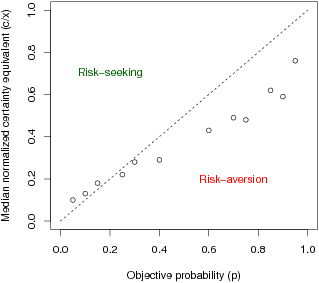
| Figure 1: A. Normalized certainty equivalents as a function of
corresponding objective probabilities based on a reanalysis of Fox &
Tversky (1998, Study 2). |
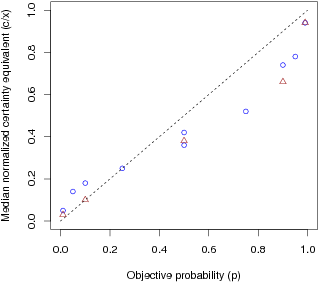
B. Median normalized certainty equivalent for positive prospects of
the form (x, p; 0, 1−p) (where x is the outcome of the gamble and p
is its probability) as a function of corresponding objective
probability for decision under risk. Triangles and circles,
respectively, correspond to values of x that lie above or below 200.
(Adapted from Figure 1 from Tversky & Kahneman, 1992).
1.1 Reanalysis of Fox and Tversky (1998)
To see how information asymmetry may contribute to the
experience-description gap, we first ask whether this gap will persist
when such asymmetry is minimized. In particular, we examine a
traditional decision under uncertainty paradigm, in which participants
decide among prospects whose outcomes depend on events that might
occur, with the probabilities of these target events learned through
error-free sampling. This paradigm qualifies as “decision from
experience” according to the definition above (there is uncertainty
and learning through sampling) but the information presented is more
equivalent to decision under risk (i.e., all necessary information to
determine the objective probability distribution over outcomes is
available).
Fox and Tversky (1998, Study 2; henceforth FT) asked participants to
observe the direction in which economic indicators moved (up or down)
relative to the previous quarter in a hypothetical economy, over sixty
quarters. Participants were informed that the probabilities of target
events remained the same for each quarter. Next, they were asked to
choose between prospects that offered $1600 if indicators moved in a
particular direction (up or down) during the subsequent quarter (e.g.,
gain $1600 if inflation goes up) versus various certain amounts of
money. From these responses they determined for each prospect its
“certainty equivalent,” that is, the sure amount of money that was
deemed equally attractive to the prospect. Figure 1A displays the
median certainty equivalent divided by the $1600 prize for each
prospect (i.e., the median “normalized certainty equivalent”), c/x,
plotted against the corresponding objective probability. This
reanalysis provides an index of median risk attitudes for prospects
with varying objective probabilities. The figure shows that
participants tended to be risk seeking (points above the identity
line) for low-probability gains and risk averse (points below the
identity line) for high-probability gains, echoing the pattern
commonly observed in studies of decision under risk (i.e., from
description, e.g., Tversky & Kahneman, 1992),
as reproduced in Figure 1B.
The foregoing analysis contradicts the generalization that EBDM
necessarily differs from DBDM and raises the question: Under what
conditions do risk preferences in decision from experience differ from
those typically observed in decision under risk? Comparing the
traditional decision under uncertainty with learning paradigm
(employed by FT), in which risk preferences accord with the
conventional pattern, and the dominant EBDM paradigm (introduced by
HBWE), in which this pattern is reversed, suggests at least two
important differences that may account for previous observations of an
experience-description gap: (1) FT participants sampled
without replacement the entire distribution of events so that
they were guaranteed unbiased information about outcomes and
probabilities, whereas HBWE participants sampled with
replacement and therefore were likely to obtain a biased
sample; (2) FT participants sampled a distribution of events
(whether inflation and/or interest rates went up or down) and then
were told associated outcomes (e.g., “gain $1600 if inflation goes
up”), whereas HBWE participants directly sampled a distribution of
outcomes (e.g., “3 points”). We explore the impact of each
of these factors in turn.
Sampling with replacement versus without replacement can make a
difference due to sampling error: small samples of binary events that
are drawn with replacement tend to under- (over-) represent very rare
(common) events. For instance, most participants sampling from the
lottery (32,.025) that offers a 2.5% chance of 32 (Problem 6) never
observed the 32 outcome. In a reanalysis of HBWE’s data we (Fox &
Hadar, 2006) examined choices as a function of the probability
distribution over outcomes that participants actually sampled (rather
than so-called “objective probabilities” that they never directly
observed) and found that choices accord with DBDM. Subsequent studies
found that the experience-description gap substantially diminishes
with larger (less error-prone) samples (Hau, et al., 2008) and when
the EBDM condition is compared to a DBDM condition that describes the
probability distribution that was actually sampled (Rakow, Demes &
Newell, 2008). Likewise, Ungemach, Chater & Stewart (2009) found
that the experience-description gap diminished markedly when
participants sampled each of the HBWE lotteries forty times without
replacement (so that there was no sampling error), though it did not
disappear completely. All of these results suggest that sampling
error substantially contributes to the experience-description gap,
consistent with information asymmetry hypothesis.
As for sampling events versus outcomes, this factor has not yet been
investigated. Note that in the traditional EBDM paradigm (as in HBWE)
participants do not learn about all of the distinct possible outcomes
unless they sample them, whereas in the traditional decision under
uncertainty with learning paradigm (as in FT) participants are
explicitly told that they are choosing between prospects that offer
the possibility of particular outcomes (e.g., $1600 if inflation goes
up and 0 otherwise), which are sometimes described as certain (e.g.,
$1200 for sure). Thus, the information asymmetry hypothesis predicts
that decisions from experience will coincide more closely with
decisions from description when: (1) a never-experienced outcome is
explicitly described as a possibility, and (2) an always-experienced
outcome is described as certain. However, sampling events versus
outcomes should not otherwise make a difference on decisions because
information provided about the probability distribution over outcomes
is otherwise the same.
2 Study 1: Information asymmetries involving never-sampled outcomes and
events
In Study 1 we independently manipulate: (a) what information is
sampled (events versus outcomes) and (b)
completeness of information described (incomplete information
in which we mention only the outcomes/events that were sampled versus
complete information in which we mention all possible
outcomes/events whether or not they were sampled). We predict that
the experience-description gap, present when rare outcomes/events are
not sampled or described, will be significantly attenuated when all
outcomes/events are sampled, or when they are all described. We
predict further that choices will not be significantly affected by
whether participants sample outcomes or events.4
2.1 Method
We randomly assigned 111 UCLA students to one of four variations of the
HBWE paradigm in a 2×2 factorial design (sampled
information: outcomes vs. events; information completeness: complete
vs. incomplete information). In the outcome sampling
conditions participants randomly sampled outcomes (e.g., 4 or 0) in the
learning phase. In the event sampling conditions
participants randomly sampled symbols (e.g., star, circle) in the
learning phase and were later told the outcomes associated with each
shape (e.g., star = 4, circle = 0).
On each trial participants sampled outcomes or events 10 times from
each of two unlabeled lotteries in any order they wished (the same
lottery pairs used by HBWE — see Table 1), then chose which lottery
they would like to play once if real money were at stake. Setting the
number of outcomes/events sampled to 10 for each lottery (20 for each
pair) holds the amount of information sampled constant across
experimental conditions, and also allows for substantial sampling
error as has been observed in previous EBDM studies that allowed
participants to sample as many times as they wished.5
During the choice phase in the incomplete
information conditions, buttons were labeled only with the
outcomes/events that a participant had sampled from each button; in
the complete information conditions buttons were
labeled with all possible outcomes/events regardless of which had been
sampled.
2.2 Results
| Table 2: Internal Analysis of Study 1 for the three lottery pairs in
which at least 20% of participants did not sample all possible
outcomes. The first two columns indicate the high and low
expected-value options. Columns 3 and 4 indicate which distinct
outcomes participants actually sampled from the high and low
expected-value options. The remaining columns indicate
the number of participants in each condition who experienced the
corresponding outcomes and the percentage of these participants
choosing the high expected value option. |
| | | | | Sampled events (shapes) | Sampled outcomes ($ amounts) |
H |
L |
Outcomes sampled | Incomplete information (n=31) | Complete information (n=27) | Incomplete information (n=30) | Complete information (n=23) |
| | | H | L | n | %H | n | %H | n | %H | n | %H |
−3, 1.0 | −32, .1 | −3 | 0 | 8 | 13 | 11 | 46 | 8 | 0 | 15 | 60 |
| | | −3 | 0, −32 | 23 | 65 | 16 | 75 | 22 | 73 | 8 | 63 |
32, .1 | 3, 1.0 | 0 | 3 | 11 | 0 | 6 | 66 | 11 | 9 | 13 | 62 |
| | | 0, 32 | 3 | 20 | 85 | 21 | 62 | 19 | 63 | 10 | 70 |
32, .025 | 3, .25 | 0 | 0, 3 | 21 | 5 | 21 | 62 | 21 | 14 | 13 | 77 |
| | | 0, 32 | 0, 3 | 9 | 89 | 5 | 80 | 6 | 100 | 8 | 88 |
Combining information conditions, we found no significant differences in
choices under the event sampling and outcome sampling
conditions for any of the six decision problems (p
> .4 in each of six two-tailed Fisher’s
exact tests), as predicted.
Note that, from the perspective of participants, the
incomplete information conditions differ from the
complete information conditions only when a rare event is
never sampled. Thus, we restrict the rest of our analysis to decision
problems that include very low-probability events so that a nontrivial
proportion of participants (at least 20%) never experienced at least
one of the possible outcomes (problems 3, 5 and 6).6 Table 2 lists the proportion
of participants choosing the higher expected value lottery in each
experimental condition, separately for each set of distinct outcomes
that a participant sampled. This internal analysis reveals that
choices were not affected by whether participants sampled outcomes or
sampled events and then had the outcomes described to them (p
> .10 for each of twelve two-tailed Fisher’s exact tests),
echoing the results of the combined analysis mentioned above. More
interestingly, every decision problem reveals a dramatic pattern in
which: (1) Most participants who experienced all possible
outcomes/events chose the high expected value lottery (consistent with
DBDM; p < .05 by sign test for every decision
problem); (2) Most participants who never experienced the
lowest-probability outcome/event and never had it described to them
chose the low expected value option (consistent with HBWE, p
< .01 by sign test in each case); (3) Participants who never
sampled the lowest-probability outcome/event but were informed that it
was a hypothetical possibility were much more likely than those not
told about it to choose the high expected value option (consistent
with DBDM, p < .002 in each case by Fisher’s exact
test).
Combining responses of participants who sampled all possible
outcomes/events (i.e., participants for whom the complete and
incomplete information conditions coincide), the proportion of
participants choosing the high-expected value option for each relevant
decision problem is displayed in Figure 2. These results support our
hypothesis that describing possible outcomes makes a difference only
when these outcomes have never been sampled so that the description
provides new information. Importantly, merely informing participants
that never-sampled outcomes are a hypothetical possibility causes
these outcomes to have as much impact on choices as if they had
actually been sampled.
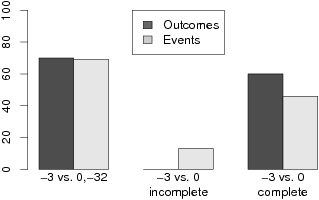
| Figure 2: A. Percentage of participants in Study 1 choosing H:
(−32,.1) over L: (−3,1) in the conditions in which all outcomes/events
were sampled, the least probable outcome/event was never sampled or
described, and the least probable outcome/event was never sampled but
was described, respectively, for the outcome sampling and event sampling
conditions. |
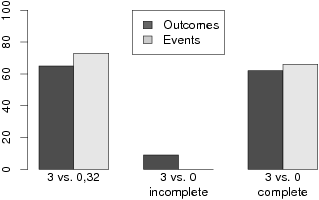
B. Same analysis as Figure 2A for H: (3,1) over L: (32,.1)
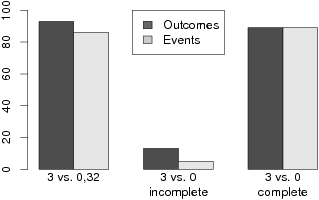
C. Same analysis as Figure 2A for H: (32,.025) over L: (3,.25)
2.3 Discussion
The results of Study 1 support the information asymmetry hypothesis
for never-sampled events and outcomes. Thus, the tendency to
“underweight” low-probability outcomes in EBDM can derive from not
considering them as a possibility; when participants are informed that
these outcomes are possible then responses accord with
DBDM.7
The observation that decisions are not affected by whether
one samples events or outcomes is important because models of
experience-based decision making typically assume sequential learning
of sampled outcomes, which is impossible if one instead samples events
and learns of associated outcomes only after sampling. For example,
the value-updating model (developed by Hertwig et al., 2006, to
account for the results of Hertwig et al., 2004) assumes that decision
makers update their estimates of the value of an option after each new
draw from that lottery by computing a weighted average of the
previously estimated value and the value of the most recently
experienced outcome. Similarly, the fractional-adjustment model
(March, 1996), invoked by Weber et al. (2004), assumes reinforcement
learning in which the initial propensity to choose each of the two
options in each decision problem is 0.5 and is updated after each
draw based on the magnitude of the sampled outcome and its valence: it
increases after a favorable outcome but decreases after an unfavorable
outcome. Neither model can readily accommodate the results of our
event sampling conditions.
3 Study 2: Information asymmetries concerning always-sampled
outcomes
Describing possible outcomes can add information not only when an
outcome has never been experienced (as in Study 1) but also when an
always-sampled outcome is explicitly described as certain. In a
previous study, Erev et al. (2008, Study 2) assigned participants to
a standard HBWE condition with unlabeled buttons or to a modified
condition in which the buttons were labeled with all possible outcomes
(e.g., “4 or 0” versus “3”). Thus, participants in the labeled
condition presumably interpreted the “3” outcome as certain because it
was the only outcome mentioned. Indeed, when the buttons were
unlabeled, only 28% of participants chose the button that always paid
3 (as with HBWE, problem 1); however, when the buttons were labeled,
60% preferred the button that always paid 3 and was labeled only with
a 3.8
The foregoing result suggests that preference for an always-sampled
outcome is enhanced when it is explicitly labeled as certain. This
information asymmetry between EBDM and DBDM should be especially
consequential when decision makers’ prior experience
primes them to treat always-sampled outcomes as less than certain.
Such might be the case, for instance, if a decision maker has
previously encountered trials in which all lottery choices offer both
nonzero and zero outcomes. We test this possibility in Study 2.
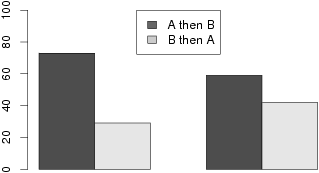
A: (3,1) ≻ (4,.8)
B: (3,.25) ≻ (4,.2)
| Figure 3: Results of Study 2. Percentage of participants who chose the
low expected value option in each decision problem, displayed by the
order in which decision problems were presented. |
3.1 Method
We presented 68 UCLA students with two decision problems, (A) (4,.8)
vs. (3,1), (B) (4,.2) vs. (3,.25), in one of two orders (A then B
or B then A). Before making a choice, participants sampled 10 times
from each unlabeled lottery in any order they wished. We predicted
that participants would be less likely to choose the sure option “3”
in Decision A if they had previously encountered Decision B in which
both options offered both the possibility of a zero outcome.
3.2 Results
The first two bars of Figure 3 present the percentage of participants
who chose the (3,1) lottery over the (4,.8) lottery for Decision A in
Study 2, listed by the order in which decision problems were presented.
The results accord with our prediction: although 73% of participants
who were first presented Decision A chose (3,1) over (4,.8), which
matches the pattern commonly found in DBDM, only 29% of participants
who were presented Decision A after Decision B chose (3,1) over
(4,.8), (p < .001 by Fisher’s exact test). This
result is consistent with our interpretation that the apparent pattern
of “risk seeking” for high-probability gains in EBDM might be driven
partly by the tendency to treat always-experienced outcomes as less
than certain.
3.3 Discussion
Results of Study 2 are consistent with the information asymmetry
hypothesis. An alternative interpretation is that the difference in
the (expected sampled) probabilities .8 and 1 appears smaller after
completing Decision B, because they are considered in the context of a
wider range of probabilities — from as low as .2 to as high as 1 (as
predicted by the “decision by sampling” model of Stewart, Chater and
Brown, 2006). Thus, probability differences would receive less weight
relative to outcome differences when Problem A comes second. Note that this
account also predicts that the difference between the (expected
sampled) probabilities .20 and .25 in Problem B would also appear
smaller when viewed after completing Problem A. In fact, there was a
nonsignificant trend in the opposite direction, as can be seen in the
last two bars of Figure 3: 42% of participants chose the (3,.25)
lottery over the (4,.2) lottery when it was presented first, but 59%
chose the (3,.25) over (4,.2) when it came second (p = .17 by
Fisher’s exact test). Thus, our result cannot be explained by range
effects as in the decision by sampling model.
4 General discussion
In this paper we explored conditions under which decisions from
experience differ from decisions from description. We defined
“decisions from experience” broadly as any situation in which a
person makes a single decision based on incomplete information about
the probability distribution over outcomes that is learned, at least
in part, through some sort of sampling process. Using this definition
we presented an example in which decisions from experience accord with
decisions from description (reanalyzing Fox & Tversky, 1998).
Contrasting paradigms, we argued that a major source of the putative
experience-description gap is informational asymmetries between the
description-based decision task (usually risk) and experience-based
decision task (usually variations of HBWE). In two studies we provided
evidence that experience-based decisions are especially likely to
diverge from description-based decisions when: (1) never-experienced
outcomes/events that might occur are never described as possibilities
and/or (2) context or prior beliefs stir some doubt that an
outcome/event that has always been experienced will necessarily occur.
Both of these conditions require at least the possibility of sampling
error — so that rare events are not necessarily experienced and/or
certain events are not necessarily believed to be certain.
We have confined our attention in this paper to paradigms in which a single
choice is made for each lottery pair. We did this because most models
of decision under risk and uncertainty, including prospect theory, are
designed to accommodate a single decision made in isolation rather
than in a series. We note, however, that an experience-description gap
has also been found in a related paradigm called “small
feedback-based decision making,” (Barron & Erev, 2003; see also
Barron, Leider & Stack, 2008; Jessup, Bishara & Busemeyer, 2008; Wu,
Delgado & Maloney, 2009). In a typical small feedback-based decision
experiment, participants do not go through a sampling phase then
decide once, but rather make a large number of repeated decisions
(usually 100 or more), each involving a very small amount of money
(usually pennies or less). Following each push of a button,
participants observe the outcome of their decision, which is then
added to their accumulated payoff counter. For example, in one study
(Barron & Erev, 2003, Experiment 2) participants were asked to make
400 decisions. They were presented with two buttons associated with
either (A) 80% of winning 4 points and nothing otherwise or
(B) 3 points for sure, where aggregate points were later
exchanged for a small amount of money (typically, a total of a few
dollars). In this case choices alternated quite a bit, but on average
participants chose (A) most of the time, the opposite preference
normally observed when people make a single decision under risk
involving the same (explicitly described) probability distributions
over outcomes (e.g., Kahneman & Tversky, 1979).
The experience-description gap observed in later stages of small
feedback-based choice cannot readily be attributed to information
asymmetries because this paradigm involves a very large number of
draws for which sampling error is likely to be minimal — participants
eventually sample all possible outcomes and there is opportunity to
develop confidence that always sampled outcomes are certain. However,
the small feedback-based decision paradigm introduces a number of
complicating factors that make it extremely difficult to ascertain the
source of the experience-description gap. Among them: small monetary
consequences for each of a very large number of choices which may
encourage experimentation and/or lead to boredom and random responses;
feedback on the total amount earned which may lead to “house money”
effects (Thaler & Johnson, 1990); some participants may invoke lay
theories of sequence such as negative recency (the “gambler’s
fallacy,” Lee, 1971) or positive recency (the “hot hand,” Tversky
& Gilovich, 1989). Another possibility is that some participants may
engage in probability matching, where the proportion of times an
alternative is selected trends toward the proportion of times in which
this alternative provides the best outcome (Estes, 1950). Testing such
possibilities is beyond the scope of the present paper but might be
explored in future research.
We assert that traditional description-based models generally perform
well in decisions from experience when they account for a decision
maker’s subjective representation of a decision problem. For
instance, before taking a long trip a driver may seem to
“underweight” and/or “underestimate” the possibility of a tire
blowout by failing to check tire wear and inflation because the
possibility of this outcome never occurs to him. However, if the
driver has experienced (personally or vicariously) a blowout or is
reminded about this possibility by a companion then he may
“overweight” and/or “overestimate” this outcome, going to great
lengths to avoid a low-probability catastrophe (blowout). In a
similar vein, an outcome that is objectively certain and has always
been experienced may be treated by a decision maker as likely but not
certain, and therefore appear to be “underweighted” and/or
“underestimated.” For instance, a business traveler might choose a
room at a hotel chain that had nice rooms and wireless Internet at two
of three previously visited properties, rather than a hotel chain with
adequate rooms that has provided wireless Internet at three of three
previously visited properties. However, if our traveler learns that
the second chain explicitly guarantees wireless Internet at
all locations, knowledge that Internet is certain might cause
him to choose this chain instead. Clearly, better prediction of
naturally occurring decisions will require a better understanding of
the role that both description and experience play and how they
interact.
References
Barron, G., & Erev, I. (2003). Small feedback-based decisions and their
limited correspondence to description-based decisions. Journal
of Behavioral Decision Making, 16, 215–233.
Barron, G., Leider, S., & Stack, J. (2008). The effect of safe
experience on a warnings’ impact: Sex, drugs, and rock-n-roll.
Organizational Behavior and Human Decision Processes, 106,
125–142.
Erev, I., Glozman, I., & Hertwig, R. (2008). What impacts the impact of
rare events. Journal of Risk and Uncertainty, 36, 153–177.
Estes, W. K. (1950). Toward a statistical theory of learning.
Psychological Review, 57, 94–107.
Fox, C. R. & Hadar, L. (2006). “Decisions from
experience” = sampling error + prospect theory:
Reconsidering Hertwig, Barron, Weber & Erev (2004). Judgment
and Decision Making, 1, 159–161.
Fox, C. R., & See, K. E. (2003). Belief and preference in decision under
uncertainty. Chapter in D. Hardman & L. Macchi (eds.),
Thinking: Psychological perspectives on reasoning, judgment and
decision making. New York: Wiley.
Fox, C. R., & Tversky, A. (1998). A belief-based account of decision
under uncertainty. Management Science, 44, 879–895.
Hau, R. C., Pleskac, T. J., Kiefer, J., & Hertwig, R. (2008). The
description-experience gap in risky choice: The role of sampling size
and experienced probability. Journal of Behavioral Decision
Making, 21, 493–518
Hertwig, R., Barron, G., Weber, E. U., & Erev, I. (2004). Decisions
from experience and the effect of rare events in risky choice.
Psychological Science, 15, 534–539.
Hertwig, R., Barron, G., Weber, E. U., & Erev, I. (2006). The role of
information sampling in risky choice. In K. Fiedler & P. Juslin
(Eds.), Information sampling and adaptive cognition. (pp. 75–91). New
York: Cambridge University Press.
Jessup, R. K., Bishara, A. J., & Busemeyer, J. R. (2008). Feedback
produces divergence from Prospect Theory in descriptive choice.
Psychological Science, 19, 1015–1022.
Kahneman, D., & Tversky, A. (1979). Prospect theory: An analysis of
decision under risk. Econometrica, 4, 263–291.
Kilka, M. & Weber, M. (2001). What determines the shape of the
probability weighting function? Management Science, 47,
1712–1726.
Lee, W. (1971). Decision theory and human behavior. New York:
Wiley.
March, J. G. (1996). Learning to be risk-averse. Psychological
Review, 103, 309–319.
Rakow, T., Demes, K., & Newell, B. (2008). Biased samples not mode of
presentation: Re-examining the apparent underweighting of rare events
in experience-based choice. Organizational Behavior and Human
Decision processes, 106, 168–179.
Stewart, N., Chater, N. & Brown, G. D. A. (2006). Decision by sampling.
Cognitive Psychology, 53, 1–26.
Thaler, R. H., & Johnson, E. J. (1990). Gambling with the house money
and trying to break even: The effects of prior outcomes on risky
choice. Management Science, 36, 643–660.
Tversky, A., & Fox, C. R. (1995). Weighing risk and uncertainty.
Psychological Review, 102, 269–283.
Tversky, A. & Gilovich, T. (1989) The Cold Facts About the
“Hot Hand” in Basketball.
Chance: New Directions for Statistics and Computing, 2, 1,
16–21.
Tversky, A., & Kahneman, D. (1992). Advances in Prospect theory:
Cumulative representations of uncertainty, Journal of Risk and
Uncertainty, 5, 297–323.
Ungemach, C., Chater, N., & Stewart, N. (2009). Are Probabilities
Overweighted or Underweighted When Rare Outcomes Are Experienced
(Rarely)? Psychological Science, 20, 473–479.
Weber, E. U., Shafir, S., & Blais, A. R. (2004). Predicting risk
sensitivity in humans and lower animals: Risk as variance or
coefficient of variation. Psychological Review, 111,
430–445.
Wu, G. & Gonzalez, R. (1999). Nonlinear decision weights in choice
under uncertainty. Management Science, 45, 74–85.
Wu, S. W., Delgado, M. R., & Maloney, L. T. (2009). Economic
decision-making under risk compared with an equivalent motor task.
Proceedings of the National Academy of
Sciences USA, 106, 6088–6093.
This document was translated from LATEX by
HEVEA.





